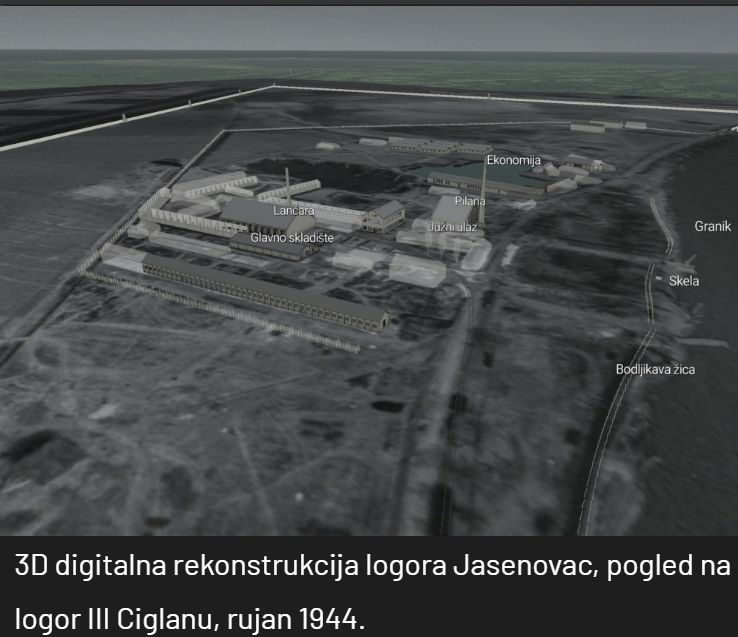Original article (in Croatian) was published on 03/11/2022
Photographs taken in 1944, according to the historian Hutinec, prove the existence of the camp as it is depicted by today’s SP Jasenovac.
Hrvatski tjednik “exclusively” published, and Croativ and Braniteljski portal reported the “evidence” of the famous revisionist Igor Vukic that the Jasenovac concentration camp is a lie. This is the same Vukic who minimized the number of dead Roma or falsified the reasons why his works ended up as an example in the Holocaust Museum in Washington. In the latest revisionist episode, Vukic uses allied photographs taken from an aeroplane in 1944.
They were discovered three years ago by the historian Goran Hutinec, but Vukic is rediscovering them, followed by Hrvatski tjednik, which writes on the cover:
No mass graves, no corpses in Sava, no crematoria, no Goldstein crushers, only six barracks measuring 24×6 meters that could hold a maximum of 1,200 detainees.
Web portals, on the other hand, write the following:
“The camp was 200 times smaller than what Klasic and the great Serbian propaganda are talking about”, said Vukic, who found the valuable photos in the US National Archives in Washington: “There is no more room for bizarre lies like Goldstein’s crushers, Dodik’s fabrications about sacks full of children with cats or Vucic’s morbid stories about soap from Jasenovac!”
This story, therefore, does not stand on several fronts. Apart from the fact that some allied photos can be found on Google for months, so we cannot talk about exclusivity, the number of barracks was not inextricably linked to the number of prisoners, at least according to Ustasha documents. Namely, in May 1942, the Command of the Ustasha Surveillance Service – Main Adjutant General “reported that the concentration and labor camp in Jasenovac can accommodate an unlimited number of detainees” (JUSP Jasenovac).

This is what Ivo Pejakovic, director of the Jasenovac Memorial Area Public Institution, tells us.
Allied aerial photographs cannot give us precise information about the number of detainees in the camp. Given that no precise records were kept in the Jasenovac camp on the number of detainees, even documents from Ustasha sources cannot provide precise data. Several documents from April and May 1942 have been preserved, stating that “the Jasenovac camp can accommodate an unlimited number of detainees”, and 1942 was the year when the largest number of mass deportations to the camp were carried out.
Barracks
That is why, continues Pejakovic, we can refer to the testimonies of individual surviving detainees. From the establishment of the Jasenovac-III Ciglana camp in November 1941 until January/February 1942, the detainees were distributed among primitive barracks and individual industrial plants that were part of the camp. The surviving detainee Vojislav Prnjatovic testifies about this:
During the first period, i.e. until January 6, 1942, 1,100 detainees were housed in three small and very primitive barracks, which had no windows but only two doors each. Those barracks looked more like pigsties than human dwellings. They were about 20 m long and about 6 m wide, while the height was about 3 m. Such a barrack was designated only for Serb detainees. In that barrack lived an average of 300 to 450 Serb detainees under terrible unhygienic conditions, formally stacked from floor to roof on top of each other, full of lice, all kinds of dirt, muddy, healthy, wet and sick – a horror, which could only be compared to hell.
Prnjatovic further describes the construction of new barracks in January/February 1942, “when it became known that an international commission would come to inspect the camp and detainees”. Camp inmates worked at temperatures 20 to 33 degrees Celsius below zero, for which numerous detainees, mostly Serbs, paid with their lives. The old barracks were then demolished, and the camp inmates were given somewhat more decent living conditions. Six modern barracks of the German folding system were built, then one barrack for the hospital, one for the infirmary, and one for the kitchen.
“Each barrack can hold around 160 detainees. In the barracks, there are boxes with two floors of beds. Each box has 6 detainees, three on the first floor and three on the second floor. I assume that Igor Vukic refers to this testimony of Prnjatovic. Not long after the construction of the new barracks, Prnjatovic was released from the camp, and in the following period of the camp’s existence, a larger number of detainees were deported when the capacity of the barracks used to be filled with twice the number of detainees”, writes Pejakovic.
Industrial facilities and sleeping under the open sky
However, some detainees were not placed in barracks but in industrial facilities within the camp. Bogdan Petkovic testifies about his arrival in the camp:
“They assigned some to sleep in the barracks, but there wouldn’t be room for everyone. A few of my group were taken in front of a building where there was a carving room on the ground floor and we would sleep in the attic of the carving room. I guess we were assigned to the construction group by then. In the attic, there is absolutely nothing to lie down on and cover oneself with”.
As part of the Jasenovac III-Ciglana camp, a part of the camp named 3-C was formed in 1942.
“It was a part of the camp without buildings, formed under a clear sky”, states Pejakovic and quotes inmate Egon Berger:
“Individuals, who were artisans, came to the workshops, while the rest went to the new camp, which was later called camp 3-C. All the groups that came, but could not immediately arrive in Gradina for liquidation, were transferred to that camp. 3-C was located on the campgrounds, under the clear sky, surrounded by barbed wire, and illuminated by searchlights at night”.
Women’s camp and liquidations
In addition to men, from June 1943, women were also imprisoned in the Jasenovac-III Ciglana camp. The beginning of the organized women’s camp in Jasenovac started in the summer of 1943 when a group of 100 women were transferred from the Stara Gradiska camp to fieldwork around the Jasenovac camp.
“Initially, the prisoners were distributed in two barracks within the camp economy. When during the winter of 1943/44 the number of female detainees increased, the female detainees were moved to a newly built one-story building in the southeastern part of the camp. The women’s camp was in operation until the penultimate day of the camp’s existence, April 21, 1945, when the last group of about 600 women was liquidated”, writes Pejakovic.
So, apart from the fact that there were alternatives to the barracks, such as sleeping under the open sky and in facilities, the number of detainees was kept under control with murders. Here, Pejakovic refers us to the statement of prisoner Djordje Milisa:
The total number of detainees in the Jasenovac hell was regularly planned to be no more than three thousand. More than that number was liquidated, and that in masses.
Pejakovic also notes that this issue does not cover the mass deportations and liquidations of Roma in the village of Ustica, the suffering of children in Stara Gradiska and nearby villages, and the fate of detainees in other parts of the Jasenovac camp. You can read his answer in full here.
Photos
Part of the photos, as we mentioned, can be obtained thanks to the historian Goran Hutinec from the Faculty of Philosophy in Zagreb, the author of a work called “Allied aerial shots of the Jasenovac concentration camp and execution ground”. The work was published in the American magazine “Holocaust and Genocide Studies” this summer.
As Hutinec explained to Novosti, access to these photos is limited due to copyright. Namely, Hutinec’s interventions on the originals clarify the details of the shots taken at an altitude of thousands of meters from allied planes. Hutinec told Vukic that, unlike him, he did not “cut out unpleasant truths – the graves in Gradina and Ustica, the digging of mass graves and the burning of corpses in April 1945, the location of the hits and damage caused by the British bombing… all that refutes falsehoods and fabrications from the pen of Vukic and the amateur fraternity”.
In his work, Hutinec also explains the location of mass graves.
“Most of the mass graves in Gradina were created in 1942, two years before the aerial photographs were taken. By that time, the bodies of the victims were already in the later stages of decomposition. Subsequent changes to the ground clearly indicate mass graves. The traces are particularly visible in photographs taken during the winter when flood waters or snow accentuated the visibility of the graves. In addition, due to the biological process associated with the decomposition of mortal remains, the grasses and plants that grew near the mass graves had a slightly different vegetation cycle compared to the plants that grew on the land that was not excavated. So, mass graves are clearly visible on photos taken in spring or early summer, because these zones are much brighter than the surrounding soil”, states Goran Hutinec in his paper.
Dimensions
Additionally, we asked the director of JUSP Jasenovac to what extent the photos match their mapping of the camp, specifically how well they confirm the 3D reconstruction published on the website of the Public Institution. Namely, Vukic claims that the dimensions of the Memorial area are a falsification, i.e. that the impression is created that the entire section from the railroad to the Sava was a camp:
It is about 500 meters from the railway to the Sava. The camp area itself is 700 by 300 meters. That’s roughly 210,000 square meters, not even half a square kilometre.

“During the creation of the digital reconstruction of the Jasenovac-III Ciglana camp, the Jasenovac Memorial area used the research by Goran Hutinec regarding allied aerial photographs of the Jasenovac camp from the Second World War. We were aware of the existence of the photograph and our colleagues who worked on the digital reconstruction of the camp used the said photographs to make the reconstruction as accurate as possible. So for us, these photos are nothing new”, answers Pejakovic. The area of the former camp Jasenovac-III Ciglana, therefore, coincides very precisely with the area of the present-day Jasenovac Memorial area.
“After all, this is confirmed by allied aerial photographs from 1944 and 1945. Also, photos from the Second World War period were taken from the railway line in the immediate vicinity of the Jasenovac-III Ciglana camp. The photos were taken by Mato Djukic, a railway worker from Hrvatska Dubica, in 1942, and Dragutin Cazin, probably in 1944 or 1945. These photos show how far the camp wall was from the route of the Sisak-Novska railway, that is, that the camp wall was located somewhat south of today’s route of the state road D47 Novska-Hrvatska Dubica”, the director states.



